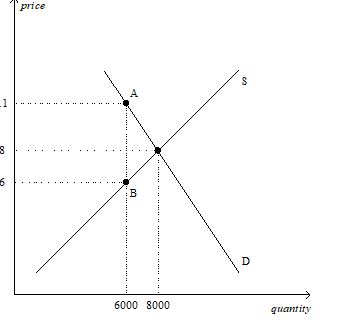Using the graph shown, in which the vertical distance between points A and B represents the tax in the market, answer the following questions.
a. What was the equilibrium price and quantity in this market before the tax?
b. What is the amount of the tax?
c. How much of the tax will the buyers pay?
d. How much of the tax will the sellers pay?
e. How much will the buyer pay for the product after the tax is imposed?
f. How much will the seller receive after the tax is imposed?
g. As a result of the tax, what has happened to the level of market activity?

a.What was the equilibrium price and quantity in this market before the tax?
b.What is the amount of the tax?
c.How much of the tax will the buyers pay?
d.How much of the tax will the sellers pay?
e.How much will the buyer pay for the product after the tax is imposed?
Definitions:
Sensory Information
Data obtained from the environment by sensory receptors, then transmitted to the brain for processing and response.
Superior Colliculi
Paired structures located on the dorsal aspect of the midbrain, involved in processing visual (and other sensory) information and coordinating eye movements.
Reflexively Duck
An automatic, quick response to move or lower the head to avoid a hazard or threat.
Reticular Formation
A complex network of nerve pathways within the brainstem involved in consciousness and the regulation of sleep-wake cycles.
Q47: Refer to Table 7-1. If price of
Q63: Refer to Table 7-11. Both the demand
Q143: Refer to Figure 6-3. In panel (b),
Q163: A key lesson from the payroll tax
Q189: Externalities are<br>A)side effects passed on to a
Q199: The price paid by buyers in a
Q272: Market power and externalities are examples of
Q302: When a tax is imposed on a
Q428: Long lines<br>A)and discrimination according to seller bias
Q453: Refer to Figure 7-12. Area B represents<br>A)the